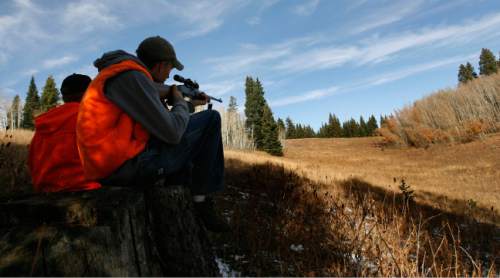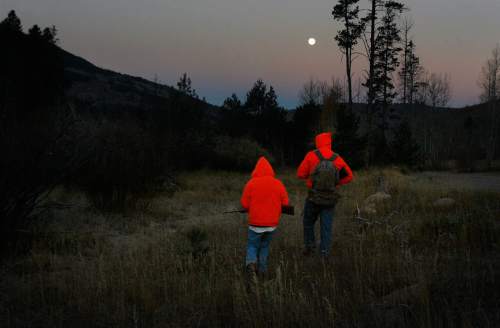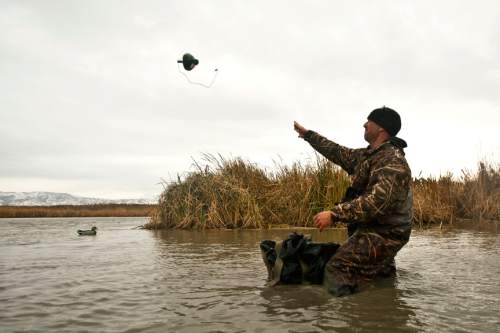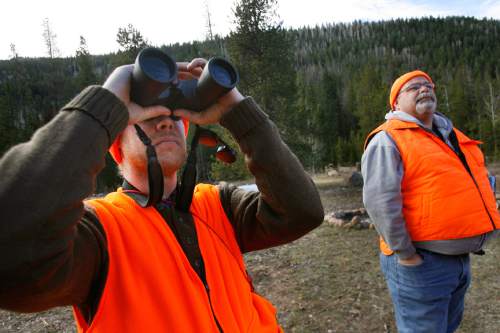This is an archived article that was published on sltrib.com in 2015, and information in the article may be outdated. It is provided only for personal research purposes and may not be reprinted.
For some Utahns, taking hunter education is as much a family ritual as baptism, getting a driver license or graduating from high school.
But others miss the rite of passage and may never participate in a hunt, even though they are interested.
This fall is the first "Mentor Hunting" and "Trial Hunting" season that allows novices to piggyback on the permits of experienced hunters or bypass hunter-safety courses until they're sure they want to take up the sport.
Utah lawmakers changed state rules during the 2014 legislative session for a "Trial Hunting" program, making it possible for those who may not have developed an interest in hunting until later in life to give it a try without having to take a hunter-safety course first.
State Sen. Ralph Okerlund, R-Monroe, the "Trial Hunting" bill's sponsor, says it's already been successful introducing more Utahns to the hunt.
"I've talked to a few people who took advantage of the program and they were really enthusiastic about it," Okerlund said. "They had daughters who didn't know if they wanted to take up hunting or not. They tried it and were really glad they did. They want to go take hunter education now and get more involved."
Lawmakers also created the Hunter Mentoring Program during the 2013 legislative session in an effort to boost the number of hunting licenses being purchased.
"For the last 15 years, nationally and in Utah, hunting and fishing licenses sales have been dropping, although they have been rebounding in recent years," said Greg Sheehan, director of the Utah Division of Wildlife Resources. "Programs like these are helping to break down some of the barriers people see when they try to get into hunting."
Critics of the laws worry loosening the rules will undermine safety training.
"Personally, I think it is the height of irresponsibility," said Gary Sackett, a board member of the Gun Violence Prevention Center of Utah. "Not only do I not see what 'problem' it solves, I see, on the contrary, the potential for tragedy."
Sackett believes such changes to gun laws are generated and lobbied for by gun and ammunition manufacturers "who are the monetary beneficiaries of putting more firearms and ammunition in the hands of more people."
But supporters say spending time in the field with an experienced hunter can be as valuable as time spent practicing for a written test and time on the range. Thirty-five other states offer "apprentice" hunting programs.
The program also provided an opportunity for at least one man to call his wife on a bluff.
"There was a husband and wife and she was talking a little smack about how bad the husband shot and she could outshoot him if she could ever find the time to take hunter education," said Farmington Bay Waterfowl Management Area manager Rich Hansen. "I told them about the new Trial Hunting Program and she was extremely excited and going right home to do it."
More than 500 people who had never taken the required hunter-education course to get a Utah hunting license participated this fall. Roughly half purchased a hunting license only and the other half bought combined fishing/hunting licenses.
The numbers are small, but Okerlund and Sheehan say they are happy with the results of the Trial Hunting Program's first year.
Participants must be 11 years old when applying for the program and 12 years old to hunt. Trial hunters must be accompanied by a licensed hunter age 21 or older and complete an orientation course and exam. Once an authorization number is approved, the trial hunter has three years to take hunter education.
Trial hunters are limited to participating in small game, upland game, waterfowl, general season deer and elk, bear, cougar, sage grouse, sandhill crane, sharp-tailed grouse, swan and turkey hunts with the proper permits. They are not allowed to hunt in trophy game areas or get once-in-a-lifetime permits.
Since receiving their authorization number, a dozen people have taken and completed hunter education. Another 23 have signed up for the hunter-safety class.
The average age of people taking part in the Trial Hunting Program has surprised wildlife managers.
"The challenge of getting youth involved has been going on for 15 or more years," Sheehan said. "An average age of 22 is a reflection of the people we should have been reaching five, 10 or 15 years ago. It is really important that we are still able to reach them."
The state Hunter Mentoring Program passed during the 2013 legislative session, but could not be implemented until 2014. Hunter mentoring allows young hunters to share a permit with an adult relative or a legal ward.
Mentors must be at least 21 years old and apply to the program for both participants. Qualifying minors must be Utah residents between 12 and 17 years old during the hunt. Only one permit is allowed at a time and a mentor can share a permit with only one youth at a time.
There were 476 participants and 516 permits issued for the mentor program in 2014. The average age of youths participating in the program was 14 years old, with the vast majority of permits — 318 total — being shared for buck mule deer. Mentors also used 103 bull permits, 75 antlerless elk permits and 12 permits for pronghorn.
Once-in-a-lifetime permits also were set aside for the mentor program: four moose; two Rocky Mountain goat, one bison and one Rocky Mountain bighorn sheep.
One man sent an email thanking the state wildlife agency for the program.
His 15-year-old grandson had completed hunter education, but too late to apply for the deer permit draw. The new program allowed the grandfather to take his grandson and share the permit. The teenager practiced shooting frequently in preparation for the hunt.
Sickness prevented the two from making it out during the opening weekend of the general rifle deer hunt, but they made it out before the season ended. They worked hard and spotted a buck with a 4-point-by-4-point antler rack.
"We were able to track, spot and shoot his very first deer," the man wrote. "One shot, one clean kill. Thanks again for this opportunity!"
Twitter: @BrettPrettyman —
Utah hunting license sales since 2008
Year All Combo/ Percent
Hunting Licenses Growth
2008 194,074 — 2009 197,282 1.6%
2010 196,637 -0.3%
2011 193,203 -1.8%
2012 194,419 0.6%
2013 205,428 5.4%
*2014 211,523 2.9%
* Year not complete until Dec. 31. Source: Utah Division of Wildlife Resources















